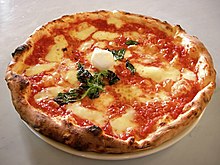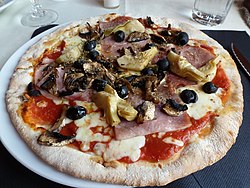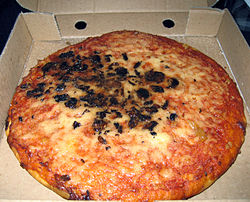Pizza
The pizza is a culinary preparation that consists of a flat bread, usually circular in shape, made with wheat flour, yeast, water and salt (sometimes olive oil). olive oil) that is traditionally covered with tomato and mozzarella sauce and baked at a high temperature in a wood-fired oven. pizzaiolo in Italian). Although its origin is considered to be in Italian gastronomy, particularly Neapolitan, its consumption is widespread in almost all countries of the world with various local variants, which incorporate different ingredients to cover the dough. Along with the hamburger, the Pizza is considered the most popular food in the world, as a consequence of the Italian diaspora that settled in America throughout the xx century, mainly in New York, Buenos Aires or Chicago.
The techniques and ingredients for making pizza have diversified enormously. The usual ingredients include olives, basil, anchovies, onion, mushrooms, ham, oregano, different types of cheese, salami, various sauces, and tomato, among others. Likewise, there are square-shaped pizzas, with thin or thick masses, with flours that are not wheat, without tomato sauce or without cheese. Although it is typically considered an artisan preparation, there are pizzas prepared in a totally or partially industrialized way ("prepizza" or take and bake) that are sold in shops.
Since 1989, the World Pizza Championship has been held annually in Italy, holding several competitions and rewarding those who obtain the first three places in each of them. In the 2018 edition, 773 pizzaioli participated (pizza chefs) from 44 countries. In 2010, the European Union recognized Neapolitan pizza as a Guaranteed Traditional Specialty (TSG) and, in 2017, Unesco recognized the art of pizzaioli Neapolitans as Intangible Cultural Heritage of Humanity.
History
Pizza's background lies in the use of wheat bread in the ancient cultures of Egypt, Persia, Greece, and Rome. In the time of Darius I the Great (521-500 BC), Persian soldiers ate a flatbread with melted cheese and dates on top. In Ancient Rome, soldiers ate a flatbread with olive oil. olive and herbs, similar to focaccia. Flatbreads with similar toppings are found in various Mediterranean cultures.
Pizza in its most traditional versions, marinara and covered in tomato sauce and mozzarella (Neapolitan), comes from the Italian city of Naples. The first references to pizza ovens date back to from the end of the 17th century. since 1732. By the middle of the 18th century, there were more than eighty pizzerias in Naples. In the first half of the xix was considered a "plebeian meal" for poor Neapolitans. Mentions of this dish can be found as early as the 1830s, for example in the book Napoli, contorni e dintorni (1830), written by a certain Riccio. visit to the Kingdom of Naples in 1835. In it a dedicates several paragraphs to pizza, which he points out as the only meal of poor Neapolitans (lazzaroni) in winter, and describes several types, most of them in bianco (without tomato), although he also mentions those that bear this fruit:
The lazzarone usually eat only two things: pizza and coconut;... coconut in summer, winter pizzas... Pizza is a kind of talmouse as it is done in Saint-Denis; it is round and loves with the same dough as bread. It comes in different widths, depending on the price. A two-wrapped pizza is enough for a man; a two-sous pizza should fill the entire family. At first glance, pizza looks like a simple dish; after the test, it is a mixed dish. The pizza is with oil, the pizza with bacon, the pizza with pork fat, the pizza with cheese, the pizza with tomatoes, the pizza with fish...Alejandro Dumas, He corrects him. (1843)
Naples had distinguished itself by having incorporated, in the second half of the xvii century, the tomato from America into the diet, while in other In European countries it was believed to be poisonous or disease-causing. Tomato seeds from Peru in the 1770s gave rise to a variety known as the San Marzano tomato, whose low acidity made it optimal for sauce preparation. bread, tomato sauce and cheese gave rise to a hot, appetizing and cheap food for the humble inhabitants of the city. The association with pasta and pizza in the 19th century made the tomato a dominant ingredient in Italian cuisine.
Although pizza made with bread, cheese, tomato, and basil dates back to at least the early 19th century, a traditional story, which has historically proven false, maintains that in June 1889, on the occasion of the visit to Naples of the Queen of Italy, Margherita of Savoy, a cook from the Brandi pizzeria named Raffaele Esposito wanted to honor her with a pizza that bore the colors of the Italian flag (white, red and green), using mozzarella, tomato and basil as ingredients, and called it pizza margherita. Gentilcore assesses that the tradition of pizza margherita combines several historical movements: on the one hand, a process of national a classic Neapolitan meal, under the influence of the Italian unification that incorporated the southern kingdom of the peninsula, until then under the power of the Bourbons, the populism of the new Savoyard monarchy and the triumph of local cuisine over French.
The Italian diaspora began in the middle of the xix century, spreading the taste for pizza to several countries in America and, finally, to the whole world.
Features
Ingredients
The ingredients of the traditional margherita pizza are:
- for the dough: wheat flour type 00, water, yeast, salt and olive oil
- for aggregate: crushed tomato, buffalo mozzarella cheese and fresh basil leaves
There are also different types of pizzas with a wide variety of toppings, such as tomato slices, various types of cheese, ham, anchovies, bell peppers, hearts of palm, salami, pineapple, eggs, mushrooms, vegetables or onions, among others.
Preparation
A crucial part of making pizza is the preparation of the dough and its proofing. The flour must be mixed by hand with the water, salt and yeast to form a homogeneous dough elastic and soft. Next, the dough must be left to rest, generally in the shape of a bun, to rise, and then it is separated to form each of the bases, generally round. The traditional pizza Napolitana uses double zero flour (which has a higher amount of gluten), a large amount of water (one liter for every 1.7 kilos of flour) and is left to rise for two days to make it more digestible, since it prevents the fermentation process from ending. in the stomach. A relatively thin disk then forms, usually the size of a large dinner plate or slightly larger. Before entering it in the oven, the surface is painted with tomato sauce and covered with cheese cut into pieces and distributed so that it melts evenly, without overflowing. The same is done in case other ingredients are added.
Baking
For the preparation of the pizza, the temperature of the oven is essential, which, for the Associazione Verace Pizza Napoletana, has to reach 420 degrees Celsius. This temperature allows cooking to be homogeneous and fast, so that the dough maintains a suitable texture and the ingredients do not burn. At that temperature the pizza should cook for about two minutes. This entire process was scientifically corroborated, with the exception of the temperature, which was determined to be 325-330 degrees Celsius with a maximum of 390 when there are many diners.
Introduction
To cut the pizza into portions, you can use a pizza cutter, a sharp disk attached to a handle and suspended by the center so that it can rotate cutting under pressure without dragging the ingredients or tearing the dough.
The traditional way of serving round pizzas is in triangular slices, usually one-sixth or one-eighth the size of the full pizza. Rectangular pizzas, typical of pizza al taglio ('pizza al corte') are usually cut into squares or rectangles.
Variants
In Italy
In Italy, the regional variant with the longest tradition is Neapolitan pizza, which is also the only type of Italian pizza recognized at a national and European level. The dough contains water, flour, yeast and salt, never oil, and the oven where it is baked must be wood-fired. Its process and ingredients are defined in the UNI 10791: 98 standard, prepared by the Associazione Verace Pizza Napoletana together with the ETG specification. This association, founded in 1984, is dedicated to promoting knowledge of artisan Neapolitan pizza. Only two variants are recognized: marinara and margarita.
In Sicily, pizzas are characterized by being rectangular and thick-crust. The Palermo pizza (sfincione palermitano), which contains tomato, anchovies, caciocavallo, onion, breadcrumbs and oregano, is very popular. In Catania the scacciata is consumed and in the province of Syracuse the pizzolo, which can be sweet or salty.
In Piedmont, particularly in Turin, you can find pizza al tegamino or al padellino. It is cooked in the pan, so the base is lightly fried and is quite thick and soft. In Marche, pizza marchigiana can be found in four variants: bianca with rosemary, bianca with onion, rossa plain and rossa with mozzarella, where by bianca and rossa is understood, respectively, with and without tomato. These derive from the oldest crescia and have in common that lard is used. Others are also made with olive oil, such as the cacciannanze from Áscoli.
In Vico Equense, a small town on the Sorrentine peninsula, the pizza by the meter has become popular, which is rectangular, contains less yeast and is fluffier and thicker due to a softer and longer cooking. Its name comes from the fact that it is sold by the meter. In Milan, the most typical is the pizza al trancio, which is tall and soft, slightly crunchy on the base and covered in abundant mozzarella. In Rome the pizza al taglio is very popular and in Liguria the sardenara. In the French region of Provence, the pissaladière is typical.
Other classic Italian pizzas include:
- Pizza capricciosa, containing mozzarella, tomato, olives, artichoke, mushrooms and ham;
- Pizza pugliese, containing tomato, mozzarella and onion;
- Pizza quattro formaggi, containing mozzarella, gorgonzola, fontina and parmesano;
- Pizza quattro stagioni, which contains mozzarella, tomato, black olives, artichoke, mushrooms and ham. The only difference with capricious pizza is the disposition of the ingredients, which are not mixed.
In Argentina
Argentine pizza is consumed throughout the country, mainly in Buenos Aires, a city that has a large proportion of its inhabitants of Italian descent and has the largest number of pizzerias per inhabitant in the world. It is characterized by the "media mass" (thicker base dough) and the abundance of cow's mozzarella cheese, "to the edges, so that it is browned and gratin", as well as the accompaniment with fainá and moscato wine. Among Among the historical pizzerias in Argentina is Banchero, founded in 1932 but originated much earlier, in the bakery installed by the Genoese Agustín Banchero in 1893, where his son Juan invented the fugazza and the fugazzetta, and the custom of accompanying it with fainá was generated. The Güerrín pizzeria also stands out, whose pizza is considered among the best in the world, with an average daily production of one thousand units, reaching 1500 on weekends. In Buenos Aires, a variant known as "pizza de cancha" is also very popular, very similar to the seafood pizza, made with dough covered in tomato sauce, without cheese and strongly spiced, which was created by street vendors after soccer games.
In the United States
American pizzas, known internationally as American pizza, originate from Italian immigration throughout the xx century and have evolved to have certain traits of his own. In general, the dough is thicker than the original Neapolitan and they tend to have more ingredients, as well as being richer in cheese and fat. They also tend to replace the olive oil in the dough with butter.
New York-style pizza is characterized by its large size and very thin crust. Its enormous size is due to the fact that it was originally sold in take-out portions. It is the quintessential pizza in New York and its entire metropolitan area, as well as many other places in the United States. The most famous variant is the cheesepizza, basically tomato sauce and cheese.
Chicago-style pizza is baked in a skillet so it has a thick, high edge, allowing for much more tomato and cheese to be added. This is why it is more commonly known as deep-dish pizza. The crust is crispy and the ingredients fall apart when cutting the pizza. It is usually eaten with a knife and fork.
California-style pizza has a thin crust like New York-style pizza, but includes ingredients typical of Californian cuisine: barbecue, pineapple, shrimp, roast duck, chicken curry, fern sprouts, and other herbs. His invention was attributed to chef Ed LaDou, although it was popularized by Wolfgang Puck.
Hawaiian pizza contains a tomato, cheese, ham, and pineapple base, usually canned, and despite its name, does not come from Hawaii. It is believed to be the invention of Sam Panopoulos, a Canadian-based Greek chef who claimed credit for its creation. Another theory says that it is a German invention. It has spread to several countries and is one of the variants of pizza that spawns greater acceptance and rejection at the same time.
Rolled pizza (pizza arrotolata), also known as Stromboli pizza, is a pizza that has been rolled up. It was created by Nazzareno Romano, an Italian resident of Philadelphia, and is considered a classic of Italian-American gastronomy. Although it is similar to the calzone, unlike this one it is cylindrical in shape and does not contain tomato sauce. The name Stromboli would later be given in honor of the film of the same name.
Other regional variants include Detroit style, St. Louis style, Quad City style, New Haven (or pizza) style, New Jersey (or Trenton) style, and beach pizza.
Other countries
In Brazil, a variety called pizza dolce is consumed, covered with dulce de leche, chocolate or fruit and eaten as a dessert. The variants that are called 'a la mexicana' or Mexican pizza include typical ingredients of Mexican cuisine. In Scotland, deep-fried pizza is sold as street food in deep-fried slices, sometimes served with salt and vinegar or with thick gravy sauce.
Although not native to Iran, Iranian or Persian pizza (پیتزای ایرانی piatzaa ayrana) has become a very popular dish, and pizzerias can be found in all major cities and towns. It is distinguished by a thick base that is crunchy on the outside and fluffy on the inside. Its ingredients are quite similar to those of the Italian, although it is more spicy.
Derivatives
- Pizza of meatballs: a New York style variant that includes meatballs.
- Chocolate pizza: sweet variant served by various pizzeras franchises, especially in Valentine's Day.
- Pizzaghetti: of Canadian origin, this variety of pizza is covered with spaghetti. It can also be presented as a combined dish of both preparations separately.
- Sushi pizza: originating from a cooking-ffusion restaurant in Canada and also consumed in the American Northwest, the dough is replaced by fried sushi rice and is covered with typical sushi ingredients: raw fish, eggs, wasabi and algae.
Pizza franchises
Contenido relacionado
Chubby girl
Aioli
Pisco (schnapps)











